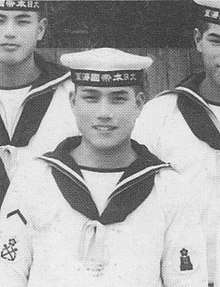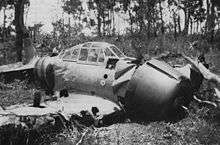Hajime Toyoshima
Petty Officer Hajime Toyoshima (豊嶋一, Toyoshima Hajime, 29 March 1920 – 5 August 1944)[1] was a Japanese airman in World War II. His A6M Zero was the first of that type (after those recovered after the attack on Pearl Harbor) to be recovered relatively intact on Allied territory when he crash landed on Melville Island, Northern Territory, Australia. Toyoshima was the first Japanese prisoner of war to be captured in Australia. While a prisoner of war, Toyoshima was one of the instigators of the breakout from the prisoner of war camp located in Cowra, New South Wales, Australia, sounding a bugle to signal the commencement of the escape, and died during the escape attempt.
Hajime Toyoshima | |
|---|---|
 Hajime Toyoshima | |
| Born | March 29, 1920 Kagawa Prefecture, Japan |
| Died | August 5, 1944 (aged 24) Cowra, New South Wales, Australia |
| Allegiance | |
| Service/ | |
| Years of service | 1938–44 |
| Rank | Petty Officer |
| Battles/wars | World War II |
Raid on Darwin

Toyoshima took part of the 19 February 1942, Japanese air-raid on Darwin, Australia.[1][3] His Zero, tail code BII-124,[3][4] was launched from the Japanese aircraft carrier Hiryū.[5] His Zero crash-landed on Melville Island,[6] where he was taken prisoner by local islander Matthias Ulungura.[4][7] Toyoshima was the first Japanese prisoner of war to be captured in Australian territorial jurisdiction.[1][8] Toyoshima suffered only superficial injuries in the crash-landing.[3] He strove to move as far away from his Zero on foot, understanding that the aircraft would aid Allied Military intelligence.[3] Before Toyoshima's crash, only nine Zeros had been shot down in the Pearl Harbor attack, 74 days before the first air raid on Darwin; their pilots had died, and the badly damaged wrecks were of little use.[3][9]
Cowra breakout
By the time Toyoshima had arrived at the Cowra POW camp, he had adopted the alias "Tadao Minami" (南忠男, Minami Tadao).[1][3] Toyoshima signaled the 1:45 am start of the mass escape of Japanese prisoners of war from the Cowra POW camp with a bugle call.[1][8] He died at some time later in the breakout.[4]
See also
References
- Steven Bullard and Keiko Tamura. "Blankets on the wire The Cowra breakout and its aftermath" (PDF) (in English and Japanese). Australian War Memorial Australia-Japan Research Project. Retrieved 24 April 2010.CS1 maint: uses authors parameter (link)
- "The Territory Remembers - Hajime Toyoshima". The Territory Remembers. Government of the Northern Territory. Retrieved 27 August 2017.
- Gordon, Harry (1978). "2". Voyage from shame: the Cowra breakout and afterwards. University of Queensland Press. ISBN 0-7022-2628-9.
- "Sergeant (Sgt) Hajime Toyoshima (left), the first Japanese prisoner of war (POW)". National Library of Australia. Retrieved 21 April 2010.
- Reid, Richard. "Australia under attack: 1942 to 1943". Australian War Memorial. Retrieved 21 April 2010.
- "Statue to honour Matthias Ullungura, first man to capture WWII prisoner of war". ABC News (Australia). Australian Broadcasting Corporation. 13 October 2015. Retrieved 4 October 2016.
- Hall, Robert (1997). The Black Diggers: Aborigines and Torres Strait Islanders in the Second World War. Aboriginal Studies Press. p. 100. ISBN 9780855753191.
- "All in - 'break-out'". www.ww2australia.gov.au. Archived from the original on 27 October 2009. Retrieved 21 April 2010.
- Rearden, Jim. Koga's Zero: The Fighter That Changed World War II. ISBN 0-929521-56-0. Archived from the original on 2008-12-27.